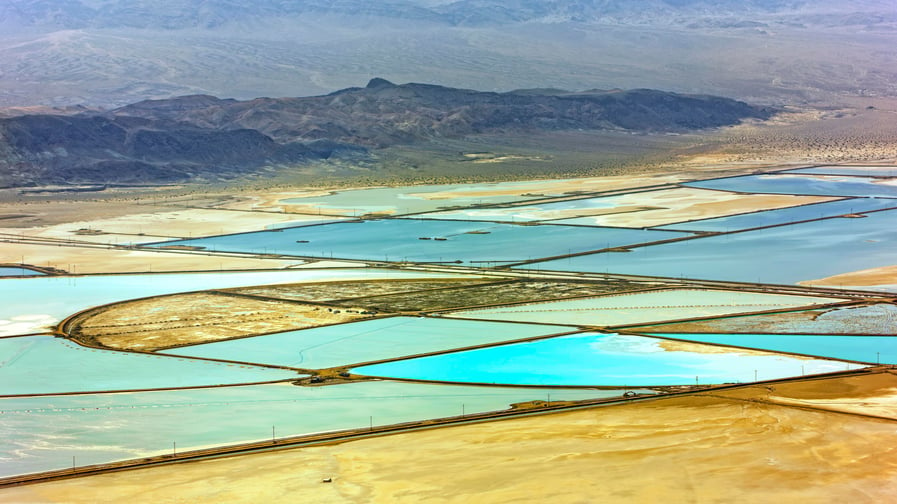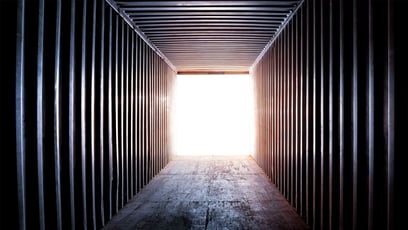Lithium is an important element in the manufacturing of electric vehicles and therefore plays an important role in the wider energy transition. But as Dominik Wilk and Diana Diaz-Valdes Teran explain in their article, while growing in importance, mining for lithium is a difficult sustainability challenge.
Since 2018, known global lithium reserves have increased by 83 percent as a direct result of intensive investment in lithium exploration projects. The reason behind this seemingly sudden interest in finding this metal is simple: lithium is the lightest metal in the world, with a much higher energy density than other metals, making it superbly energy-efficient and the top choice for electric car batteries. This is especially important because electric land-based transportation has recently become one of the pillars of the international plans for an energy transition which urgency is only increasing. As a result, in 2020 the European Commission (EC) added lithium to the List of Critical Raw Materials. The EC acknowledged at the time that, while lithium is essential for a shift to e-mobility and that by 2050 Europe will need up to 60 times more of it for e-car batteries and energy storage alone, “we cannot allow to replace current reliance on fossil fuels with dependency on critical raw materials”, and committed to diversified, sustainable and socially-responsible sourcing of materials.
External sources: the impact of lithium mining on indigenous peoples around the world
According to the International Renewable Energy Agency (IRENA), an intergovernmental organisation that supports countries in their transition to a sustainable energy future, approximately 80 percent of lithium projects are located on or near indigenous peoples' land around the world. Indigenous peoples have historically been marginalised and often face discrimination in their countries’ legal systems which hinder their economic, political, and social development, and exposes them to abuses. While constituting only 5 percent of the world’s total population, traditional indigenous territories encompass up to 22 percent of the world’s land surface and coincide with areas that hold 80 percent of the planet’s biodiversity, and are rich in natural resources including oil, gas, and minerals. For this reason, indigenous peoples’ rights, which have been traditionally linked to the land they inhabit, have often collided with the interests of extractive industries.
While constituting only 5 percent of the world’s total population, traditional indigenous territories encompass up to 22 percent of the world’s land surface and coincide with areas that hold 80 percent of the planet’s biodiversity"
An example of such a collision has occurred in Argentina during the exploitation of the lithium deposits of Jujuy, in what has become known as “the lithium triangle”. The exploitation of Jujuy is allegedly causing water scarcity and pollution, which has led to local indigenous communities marching under the chant “water is worth more than lithium”. This is because lithium mining requires large amounts of water use, can contaminate ground water and can cause air pollution. Aside from the potential adverse effects of the lithium sourcing process itself, indigenous communities around the world have also protested against what they view as the privatisation of their ancestral land. For instance, historically, local indigenous communities in Jujuy had rights to use the local land until extractives arrived in the 2010s and the lithium extraction began. In 2023, local politician Carlos Sadir won provincial elections in Jujuy and appointed Governor Gerardo Morales. Morales was immediately tasked with reforming the local constitution to promote public lands for “productive” uses, while cancelling the delivery of land titles to local indigenous communities. The reform took place within a week, leading to widespread protests. The local authorities were subsequently accused of having used excessive force against protestors by several human rights organisations.
Similarly, in Bolivia, lithium projects in salt flats have been reported as causing water scarcity and water pollution in Calcha K, in the Uyuni and Pastos Grandes salt flats, two of Bolivia’s three major lithium reserves. In 2023, the Bolivian government announced several agreements to build lithium complexes in the area with Russian and Chinese consortiums. Although the Bolivian authorities have referred to a process of “consultation” with local communities, local attendees claim that they did not feel that they were part of a true “consultation” and rather were informed. Meanwhile, in other parts of the world, such as Zimbabwe, Namibia, and DRC, Global Witness has found that the rush for lithium is bolstering risks of corruption and other ESG risks, stating: “For generations African nations have been exploited for their minerals, and as the demand for ‘transition minerals’ increase, there is a danger of history repeating itself.”
Is the EU ready to bring lithium mining home?
For the European Union, the partial solution to address environmental and human rights concerns might be to source lithium domestically, controlling every stage of the process including mining, refining, and production of batteries and electric vehicles. Currently, Europe is heavily dependent on external sources, with South America and Australia, who have the largest lithium deposits in the world, supplying over 87 percent of unrefined lithium used in Europe. In order to be used in high-tech manufacturing, lithium and other critical minerals need to be refined, and the global leader in this process is China, with over 50 percent of worldwide output.
EU politicians have been seeing ways to reduce dependency on external sources [of lithium]... this trend has accelerated due to the ongoing US-China trade war"
EU politicians have been seeking ways to reduce the bloc’s dependency on external sources of this vital element. This trend has accelerated in recent years due to the ongoing US-China trade war and the resulting geopolitical uncertainty, as well as realisation of overdependence on global supply chains from remote parts of the world, which could be easily cut off in case of another crisis like the COVID-19 pandemic. Moving just a share of lithium extraction and refining to Europe would give the bloc more control over the way its sourced and a chance to mitigate some of the negative impacts. Currently, there are six lithium mining projects in development within the EU, all at various preparatory stages, with the first one, located in northern Portugal, expected to start regular operations in 2026.
The first step towards the EU’s partial lithium self-sufficiency was the Critical Raw Materials Act (CRMA) – a framework document establishing a roadmap for the secure and sustainable supply of 16 raw materials, including lithium, graphite, cobalt, silicon, and so-called rare earth metals. The document was presented by the Commission in March 2023, and is currently waiting for the approval of the European Council, with an expected entry into force as early as April 2024. The goals of the CRMA are ambitious and include diversifying supply – by 2030 no non-EU country should supply more than 65 percent of EU’s annual needs – and kick-starting sourcing within the EU – with targets for internal extraction, processing, and recycling, set at 10, 40, and 25 percent, respectively. Both mining sector representatives and green transition advocates have stated that these aspirational targets look promising on paper, but the road towards their implementation is likely to be long and face several hurdles.
Funding remains the key challenge, as the cost of a lithium mine with an adjacent refinery is between USD 400 million and USD 500 million. The majority of eligible big players in the mining sector which would be able to secure financing for projects of this scale, are not based in the EU and tend to focus on mines exploitation rather than on high-risk initial geological exploration. Conversely, the European mining sector is more fragmented and therefore banks are unlikely to be interested in providing funding for such projects to companies with smaller market values. What could help to strengthen their case and attract more investment, is designating these projects as strategic, propped up by strong financial backing from the EU and member states’ governments. The French and German governments have already pledged to contribute over EUR 1.5 billion to support lithium mining initiatives.
Another challenge waiting to be addressed by the CRMA is the bureaucracy involved in a project of such magnitudes. At present, new mines take decades to get approved"
Another challenge waiting to be addressed by the CRMA is the bureaucracy involved in a project of such magnitude. At present, new mines take decades to get approved – the abovementioned project in north Portugal, due to go live in 2026, received its mining lease in 2006. These delays are caused by the numerous environmental approvals needed for such projects, lengthy legal disputes with a long appeals chain, and local residents’ opposition which results in volatile political will. The new act is expected to reduce permit waiting time for strategic projects to two years; however, coordinating EU-wide regulations in this regard may prove difficult, as mineral resource management, permitting, and mining legislation fall within the full competence of the member states. The mining industry claims that one of the solutions is relaxing some environmental impact requirements, which is seen by environmentalist groups as a step backwards in preserving nature and biodiversity, turning the “green” transition into a “black” one.
A stumbling block that is much more visible is the opposition from local residents in Europe. So far, there have been protests from residents against lithium mining projects in Portugal, Spain, Czechia, and France, among others, and in case of any opposition that finds its way before a court, the mining project can be stalled for months, if not years. A similar opposition came to a boil in Serbia, an EU candidate country, where weeks of widespread, mass protests led the government to revoking the lithium mining licences granted to Rio Tinto, the only major mining company engaged in this type of project in Europe, in January 2022. In Cáceres, Spain, 22 out of the town’s 25 councillors opposed the plans to use unprecedented EU funding to develop a lithium based mine as this posed a threat to its local heritage. Up to this date, the project has not initiated. European lithium projects may also face concerns regarding land use rights and water pollution by indigenous communities, such as the Sami who live in northern Scandinavia. It is worth noting that several Sami communities have in the past brought their governments to the UN Human Rights Committee over alleged violations of their cultural rights. These examples accentuate the need to expand public consultations at the permitting process and increasing transparency supported by pre-due diligence and stakeholder mapping.
As the green transition becomes an ever urgent point of the EU’s agenda, the bloc’s pursuit of increasing its lithium supply faces significant financial and human rights challenges."
As the green transition becomes an ever urgent point of EU’s agenda, the bloc’s pursuit of increasing its lithium supply faces significant financial and human rights challenges. The impact on indigenous peoples’ and overreliance on China and global supply chains, are intensifying, while the European plans of sourcing lithium are hindered by lack of funding, bureaucracy, and local communities opposition to mining projects. While the EU institutions’ recent legislation to address these issues is promising, establishing a self-sufficient lithium supply chain remains questionable without the required funding streams and strong community consultation to grant mining permits and avoid revoking lithium licences down the line.




